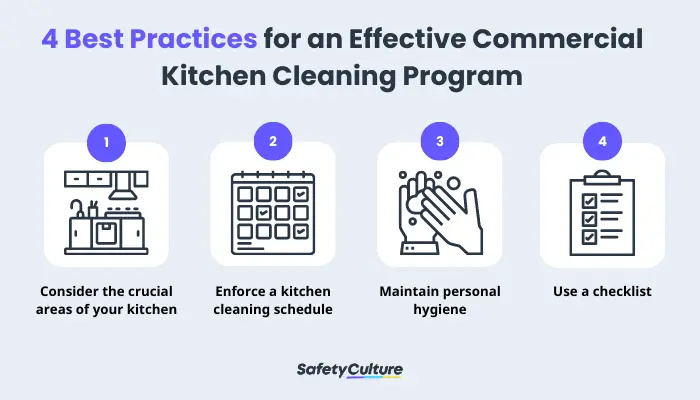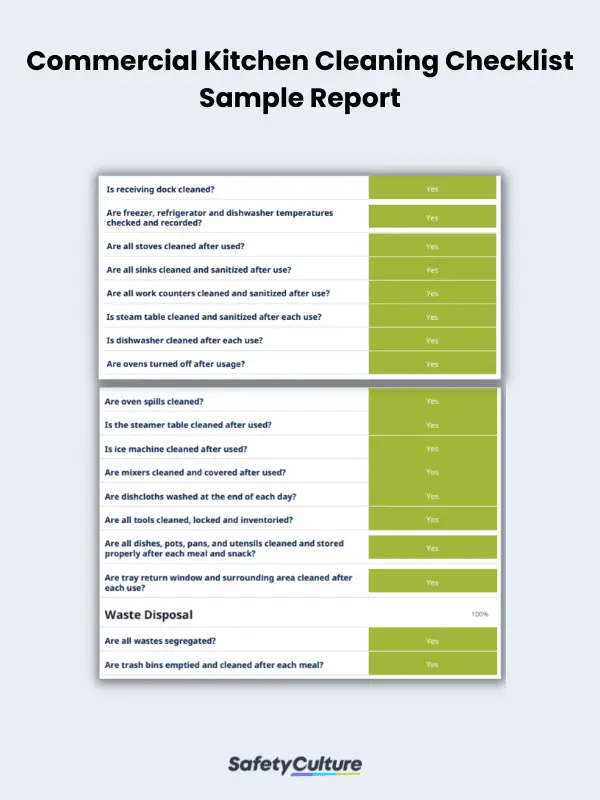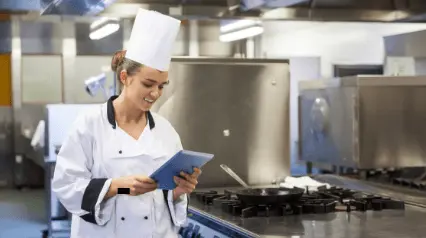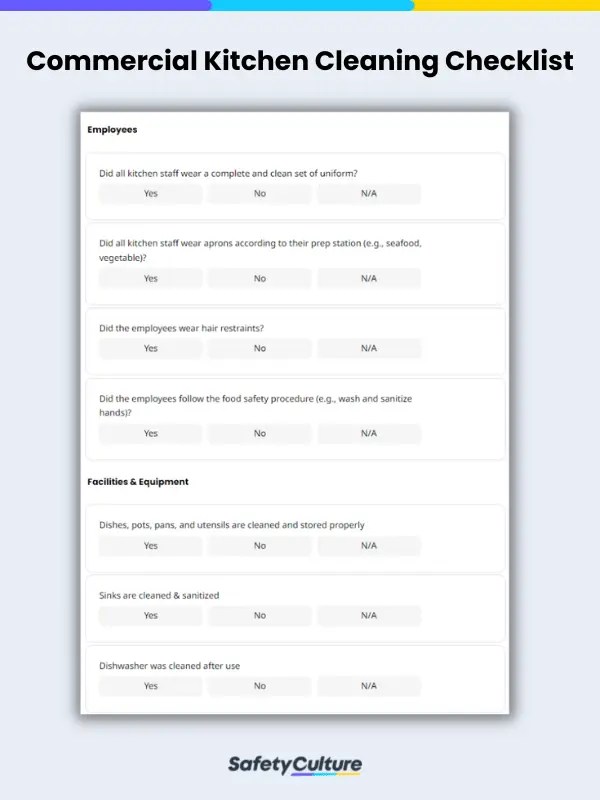What is a Kitchen Cleaning Checklist?
A kitchen cleaning checklist is a tool used to maintain and ensure a hygienic commercial kitchen facility. It can help staff keep track of required cleaning tasks and follow kitchen standard operating procedures. Following good kitchen housekeeping practices with the aid of a kitchen cleaning checklist is important for passing health inspections and preventing food contamination.
Best Practices for an Effective Commercial Kitchen Cleaning Program
Commercial restaurants, hotels, delis, grocery stores, and other food establishments should always be prepared for random food vendor inspections. Poor kitchen hygiene and practices can put your business at risk of fines, bad score ratings, and even shutdown. Some of the most common cleaning methods used in commercial kitchens are:
- Manual cleaning — Cleaning that is done manually without help from machinery
- Mechanical cleaning — Cleaning that involves automated cleaning and washing equipment
- Clean-in-place cleaning — Cleaning that involves large items that can’t be moved around, so they must be cleaned in-place
Here are 4 commercial kitchen procedures you can follow to prepare your business for passing health inspections:

Consider the Crucial Areas of Your Kitchen
Ensure kitchen safety and that all areas in the kitchen receive proper attention, especially those that tend to get overlooked. The most frequent question is, “How do I clean my kitchen every day?”. This can be answered by attending to the following key areas to maintain a hygienic kitchen.
- Kitchen floors – Kitchen floors should be properly cleaned and sanitized on a daily basis before closing. Improper cleaning can result in trips and falls, foodborne illness caused by bacteria buildup, and attraction of vermins due to food build up.
- Kitchen sinks – Disinfect kitchen sinks to avoid bacteria buildup. Scrub, sanitize, and keep it stain and clog-free to avoid plumbing issues.
- Kitchen equipment – This refers to all kitchen utensils such as pots, pans, knives, and other frequently used items. They should be cleaned after every use to avoid the transfer of bacteria.
- Preparation tables – Keep them clean after use. It is crucial to sanitize food contact surfaces to avoid food contamination and other health-related issues.
- Ovens – Remove grease spills and debris using a washcloth, brush, or scraper to eliminate buildup. Daily cleaning of ovens can reduce the risk of oven fires.
- Walk-in refrigerators – Refrigerators store a variety of food products, so it is crucial that they are kept clean and bacteria-free. Thoroughly sweep and wipe the floors and wipe ceilings and walls regularly. Shelving units should also be cleaned and organized weekly.
- Dumpster pads – Dumpster areas should also be kept clean despite being located outside the kitchen facility. Improper trash disposal can attract vermin and can lead to an infestation. Routine cleaning and proper waste disposal can help maintain a safe environment for people who come in contact with your dumpster pads.
- Exhaust hood systems – Improve ventilation and reduce risks of kitchen fire by routinely conducting a deep cleaning of the exhaust ducts, plenum, and roof exhaust fan.
Enforce a Kitchen Cleaning Schedule
Commercial kitchens can be a hotspot for germs and bacteria. Prevent bacteria build-up and keep consumers safe by implementing a strict kitchen cleaning schedule. Develop a list of tasks and choose which should be done on a daily, weekly, or monthly basis. A kitchen cleaning schedule can lower the likelihood of foodborne illnesses and reduce food waste.
Maintain Personal Hygiene
Many cases of food poisoning are caused by the lack of personal hygiene from food handlers or the kitchen staff. Personal hygiene in commercial kitchens entails wearing proper attire such as a clean uniform, aprons for different prep stations (e.g., seafood, vegetable, etc.), gloves, hairnets, and shoes (non-slip, fully covered).
Aside from attire, simple actions such as washing hands, keeping fingernails short and neat, etc., should also be practiced as part of personal hygiene.
Use a Checklist
Keep track of what needs to be accomplished using a detailed checklist. Kitchen cleaning involves numerous tasks that can be overwhelming and difficult to remember. A checklist will ensure that you cover all the bases.
How to Use a Kitchen Cleaning Checklist
Before anything, determine how often you want to clean your kitchen. Different kitchens and commercial establishments work differently, but there are some tasks that you should be doing daily or as often as possible, such as cleaning utensils after every use, wiping spills from counters every time, and sweeping your floor. There are also tasks you can afford to do weekly instead, depending on the situation. However, you should deep clean your kitchen at least once a month.
A commercial kitchen cleaning checklist is good for all these tasks as it is used to assess if a commercial kitchen follows standard cleaning protocols. As cleaning is a task that requires you to move constantly, it is also essential to have your kitchen cleaning checklist somewhere accessible at all times. It can be on the walls where people always pass by or with you at all times.
A more efficient way to create, store, and fill up a kitchen cleaning checklist, however, would be to use a digital one. A digital kitchen cleaning checklist provides the following benefits:
- It is easy to access anytime and anywhere
- It helps reduce paper waste as everything is online
- It is not easily destroyed unless deleted
What to Include in Kitchen Cleaning Checklist
A typical kitchen cleaning checklist will often prompt for the following to be cleaned:
- Dishes, pots, pans, and utensils
- Sinks
- Dishwashers
- Tray return areas
- Stoves and ovens
- Flooring
- Rags
- Other cooking equipment
Here is an example of a kitchen cleaning checklist report for reference:

Commercial Kitchen Cleaning Checklist Sample Report
In some cases, a kitchen cleaning checklist can also include a portion on waste segregation and management. Though this can be a different act altogether, waste management is also an important part of kitchen cleaning, so it can be helpful to consider this as well.
The same can be said for proper clothing and protective gear in the kitchen. While it is not quite part of kitchen cleaning, noting what your staff is wearing and ensuring they are following the set safety and hygiene guidelines of your kitchen are also important.
FAQs about Kitchen Cleaning Checklists
It is usually the business or kitchen owner who makes any checklists in a commercial kitchen or restaurant. This is to ensure consistency in what to look out for in cleaning procedures. For this reason, checklists are often created in templated forms for easy usage.
Yes, your cleaning checklist can also be used for sanitizing your kitchen. However, it is important that cleaning and sanitizing are two different things. Cleaning refers to the act of removing visible dirt and grime from a surface; on the other hand, sanitizing refers to the act of removing pathogenic microorganisms.
To properly sanitize a kitchen, you must first clean it thoroughly. After that, use safe household bleach or a commercial sanitizing solution or product.



